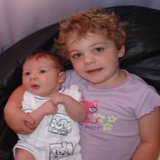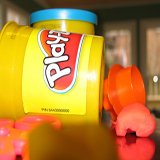Stimulating Eye Hand Coordination - 25 Month Old to 30 Month Old
Your child has a clearer understanding of his abilities in terms of eye hand coordination; in other words, he is developing a more defined self concept of what he can and cannot do.
He chooses to use his talents in ways that he sees fit. To improve hand eye coordination, for example, enables him to be more independent, to pick up and manipulate objects without having to ask you for help.
He thoroughly enjoys this increasing freedom.
Suitable suggestions for Eye Hand Coordination
(25 Month Old - 30 Month Old)
Assertive Discipline
Your toddler occasionally tries to impose his ideas on other people within the family, whether they like it or not.
For instance, if he wants you to read him a book, he looks for it, finds it, brings it over to you and puts it on you lap; if he thinks that it is time for something special to eat, then he goes to the cupboard, selects the item and brings it to you.
However, his increased assertiveness stems from his developing skills, not from any underlying character trait. But you'll probably need to practice assertive discipline yourself, in order to ensure that he doesn't end up in charge!
Opening Packages and Unwrapping Parcels
Invite him to open packages for you. This could be a paper bag containing a food item, or a wrapped parcel, or a screw-top jar.
His eye hand coordination is developed enough for him to be able to cope with many of these manual challenges. Use events that arise in your daily routine, such as getting a slice of bread from the packet or opening the breakfast cereal box.
If it proves too much for your child, half open the packet for him and leave him to complete the job.
Buttoning Skills
Practice fastening buttons with him.
Instead of using his clothes, take a small square of cloth and sew three large buttons on to it, spaced at least two centimeters apart. Take another piece of cloth and cut three large buttonholes in it, matching them exactly to the spacing of the buttons on the other piece of cloth.
Now you have all the equipment need for your child to improve his buttoning skills. At first, he should try to complete only one button at a time, but once he has mastered this, suggest he fastens two buttons to the top cloth and then three.
Child Drawing
Your child's maturing drawing skills mean that he is more able to copy shapes accurately. While he watches you, draw a vertical line on a piece of blank paper and tell him to 'draw one just like that'.
His line will be shaky but it will be clear and in the correct orientation.
Top Tips for Eye Hand Coordination
(25 Month Old - 30 Month Old)
- Teach him baking.
- Show him how to use cutlery.
- Give him varied drawing and painting equipment.
- Praise his independence.
- Buy him a toy tool set.
He delights in mixing play dough, rolling it out on the table and cutting it into small shapes.
Watch his face when he sees his own 'biscuits' brought fully baked from the oven. He wants the whole family to taste them.
He already uses a spoon but try to teach him how to use cutlery in each hand.
Start with a fork in one hand and a spoon in the other. This takes time to master.
Buy a range of colored pencils, crayons and types of paper so that your child has choices when it comes to creative activities.
Encourage him to vary the materials he select.
Each new stage of personal independence brings him pride and boosts his self confidence, especially when he knows you are pleased with him.
So, for example, give him a big cuddle when he manages to dress himself more or less properly.
He will not only improve his eye hand coordination, but also improve imagination by pretend playing with plastic tools.
Actions such as sawing, hammering and turning a screwdriver all provide excellent practice.
Top Toys for a 25 Month Old - 30 Month Old
- sand and water trays
- modeling clay
- crayons and paper
- soft ball
- toy car
Be sure to browse through all the eye hand coordination pages that is broken down in different age groups.
Find It!
Can't remember where you read something specific? Just type in your search term in the box below and your specific topic will be returned to you instantly.









